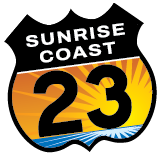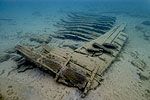GPS Location : N45° 02.579' W83° 14.425'
Depth: 15 Feet
Wreck Length: 130 Feet Beam: 27 Feet
Gross Tonnage: 610 Cargo: Passengers and freight
Launched: 1838 by B.F. Goodsell at Detroit, Michigan
Wrecked: June 14, 1849
Description: The New Orleans was originally called Vermillion, but it was rebuilt and renamed New Orleans after a disastrous fire in 1842; it was also lengthened from 131 to 165 feet at the time. During the night of June 13,1849 it was steaming North on Lake Huron when it ran into a heavy fog off Thunder Bay. Early on the 14th, it strayed from its route and ran onto a reef at Sugar Island. Her passengers were transferred safely to Thunder Bay Island by local fishermen, and later picked up by a passing steamer. Strong winds and waves destroyed the stranded vessel a few days later. Click here to read more about the New Orleans.
Thunder Bay National Marine Sanctuary: Enjoy diving the wrecks of Thunder Bay, but always respect the past. State and federal laws prohibit removing or disturbing artifacts. Future generations are depending on us to leave historic shipwrecks intact. Please take only pictures and leave only bubbles. Thunder Bay National Marine Sanctuary Shipwreck List
The Thunder Bay National Marine Sanctuary maintains seasonal moorings at many shipwreck sites. Available from May to September, the moorings make for safer diving and also protect shipwrecks from anchor damage. Sanctuary regulations require vessels to use moorings when present. Mooring Buoy Interactive Map
Things To Do
Scuba Diving or Snorkeling



